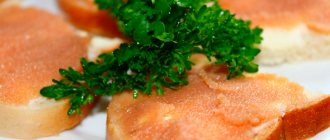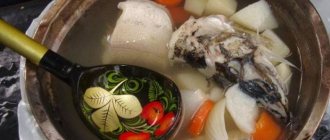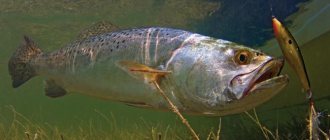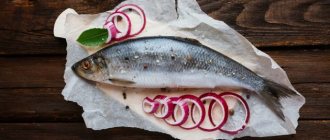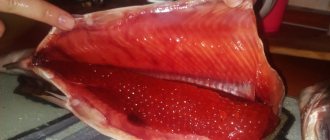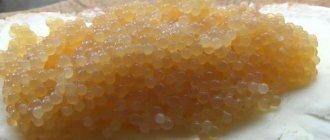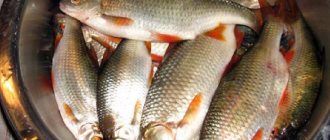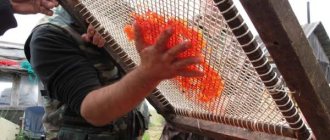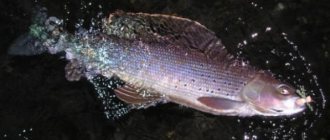Pike perch is delicious in any dish, although the fish meat is lean and there is practically no fat! Only in winter does the predator fatten up tasty fat, so it is better to dry pike perch from October to April. The meat of dried fish has a specific taste, a little dry, but tasty. It is better to dry small pike perch; you don’t have to gut them; your stomach is almost empty. Carcasses weighing more than 1.5 - 2 kilograms must be gutted; they (especially in the fall) are filled with half-digested food. This causes fermentation, rotting. It is better to cook other delicacies, such as fish balyk.
How to dry pike perch
The recipe is simple, salting, soaking and drying. At home, it is better to salt pike perch for drying by dry salting; everything tasty remains in the meat + soaking time is reduced. Fresh fish carcasses are not washed; external dirt and mucus are wiped with a rag, paper towels... Salted with coarse salt, 250 grams of salt per kilogram of fish. Strong salt kills parasites that are abundant in freshwater fish. Otherwise it will turn out like in the joke:
— Congratulations on the birth of a new life! - Doctor, I'm a man. - Well, actually, worms don’t give a damn!
Salt in enameled, wooden, food-grade plastic containers that have holes for liquid drainage. As it salts out, brine appears; if there is no drainage, it must be drained. The released fish juice reduces the salt concentration of the brine. Each fish is rubbed with salt against the scales; the gills (can be removed) are salted especially generously. The carcasses are placed back down in a bowl, the remaining salt is poured on top. The salting container is covered with a smaller plate and pressed down with heavy pressure to squeeze out air and ensure uniform salting.
The released brine should be clean, cloudiness + an unpleasant odor is a sign that the pike perch has begun to spoil before salting! If the first brine is bloody, drain it and add a little salt! Small fish are salted for 6-8 days, from 2 kilograms for thirteen or more days. Maintaining temperature is very important! Salting is stored at a temperature of 7-10 degrees. If it is higher, only a refrigerator or a cold cellar, otherwise an unpleasant odor may occur and it may disappear altogether. A properly salted carcass is firm, the thick back is shrunken, the belly is dense and does not squish. A soft back means the salting is hopelessly spoiled, decomposition has begun!
The next stage is soaking. There is a rule: the number of days it is salted, the number of hours it is soaked in cold water. It doesn’t always work, I advise you to try the fish meat with salt, then the dried pike perch will turn out moderately salty and tasty. If you can hardly feel the salt, then it’s time to hang it out for drying. Place the fish on newspapers and let them dry thoroughly. To remove abdominal fluid, the fish are hung upside down. The gill covers and mouth open. After a week and a half, it is advisable to rehang the weight the other way around, then the carcasses will dry evenly. It is better to dry pike perch in the fresh air, in a well-ventilated place. In rainy weather it is necessary to move it to a room with good ventilation. In spring/autumn, dry a kilogram of ungutted pike perch for an average of 2.5-3 weeks. You can store it in the fruit drawer of the refrigerator; tightly wrapped in baking paper, it will last for 2-3 months.
We also read: Drying perch.
Add a comment Cancel reply
You must be logged in to post a comment.
Salting fish can significantly increase its shelf life and give it a special taste. Pike perch, depending on its size, is salted whole or in pieces, sometimes with the addition of spices for salted consumption or for subsequent smoking or drying. And also, the caviar of this fish is salted separately, and in various ways. Before salting pike perch, it must be prepared.
Instructions
First you need to prepare the pike perch
to salting. To do this, rinse it thoroughly under running cold water until the mucus disappears.
Clean the washed fish from scales and gut all the insides. It is important not to damage the bile. Otherwise, the fish will become bitter, making it unfit for consumption.
If the fish is large, then it is necessary to make an incision along the back to avoid subsequent damage.
Then rinse off the pike perch
remnants of scales and blood.
Take 150 grams of coarse table salt (you can use sea salt). Rub the entire fish thoroughly, paying special attention to the gills and the cut along the back (pour salt into these places). It is better to use more salt than not enough salt (then it will definitely not spoil).
Pike perch prepared in this way
place belly up in the barrel. The container must be clean and free of foreign odors. At the same time, do not forget to sprinkle the rows with salt, peas and bay leaves. Spices will give your fish a unique taste. The most salt should be in the top rows.
Close the barrel with a wooden lid and place pressure on top.
Large fish should be salted in a cool place for 15 days, and small fish should be salted for 4 to 5 days.
There are many different ways to prepare fish - with marinades, sauces, stuffing, on a bed of vegetables, etc. The result is delicious dishes, but the fish itself sometimes fades into the background, and even into the background. Meanwhile, its pure taste also deserves attention.
Pike perch baked in salt is unusual, unusual, but very simple and very tasty. Large or medium-sized carcasses are suitable for cooking fish this way.
How to wilt pike perch
Salted carcasses should be washed with cold water. If the density of the pulp is very high, then it is better to soak it for 6-12 hours, changing the water 2-4 times. When the pike perch begins to float, it means it is ready for drying. For this:
- the carcasses are lightly dried on soft paper or newspaper;
- strung on twine or cord;
- grease with vegetable oil or table vinegar;
- hang in boxes covered with gauze;
- place in a shady, well-ventilated place.
If drying takes place in winter, you can hang it in the kitchen near the stove. The optimal temperature for the process is 20 degrees, the time is from 2 weeks to 1 month. If you want more fat to remain in the fish, it is better to hang it upside down.
How to pickle pike perch caviar
If the caviar is frozen, it should be thawed; fresh caviar should be removed from the fish. For 600 g of caviar you will need to take:
- 3 liters of boiling water;
- 6 tbsp. l. salt;
- 2 tbsp. l. vegetable oil.
The cooking process consists of several stages:
- Chop the caviar in the eggs with a knife in several places.
- Pour boiling water over, stir with a fork, wrapping the film.
- Place in a fine sieve.
- Pour 2 full tablespoons into water (2 liters). l. salt and boil.
- Pour the hot brine over the caviar and continue to collect the remaining film with a fork. At the same time, the pike perch caviar will change color.
- Repeat the procedure 3 times. At the end the caviar will become very light. Almost white.
- Pour half the vegetable oil into a sterile jar, then put the caviar and pour the rest of the oil on top.
- Place in the refrigerator.
After 6-8 hours, the delicacy is ready to eat, preferably on sandwiches with butter.
Salting pike perch caviar
The thicker and fattier the pike perch, the better its caviar tastes. Fresh caviar is salted. Caviar from thawed carcasses tastes much worse; it is better to cook other dishes from it.
First, the caviar, packed in film (yastyki), should be carefully removed from the fish carcasses, remembering the unpleasant consequences of a bile spill, which will significantly spoil the taste.
The oysters are washed, freed from mucus and prepared for salting. It can be in two forms:
- Ambassador of caviar mass.
- Salting caviar in eggs.
How to salt pike perch caviar in the form of a homogeneous mass
- The first operation is punching, freeing the calf from the film
There are different methods, which one you like best.
- Winding the film onto a fork or knife.
- Rub through a grater with smooth holes, a sieve, a colander. The sharp edges of the holes will ruin the shape of the eggs.
- Scrolling through a meat grinder.
- Pouring boiling water causes the pieces of film to curl up, and it merges with the water.
The latter method guarantees the destruction of germs and pathogens. Scalded or steamed caviar is the safest. After pouring boiling water over the caviar, stir it for several minutes and steam it at the same time, then rinse with cold water until all the pieces of the film are washed off.
- Second operation - ambassador
Quick Ambassador
After punching, the eggs are washed several times with cold (or ice) water until the drained water becomes absolutely clear. Then simply add salt and pepper (salt like a regular dish), mix well, and let sit. After a few hours, the caviar is ready. You should be on the safe side: start eating not after three hours, but wait 5-8 hours.
Second option. The punched caviar mass is placed in a colander or sieve. Scald the caviar with boiling water, immediately rinse with cool water and allow the remaining water to drain. Place on a napkin to dry slightly. Then transfer to a bowl, add salt and white pepper, lemon juice and a little vegetable oil. After cooling, the dish is ready for sampling. The result is five-minute lightly salted caviar.
Salting pike perch caviar in brine
A more labor-intensive and safer method is to salt the caviar in brine. For every liter of water take 100 g of salt.
Boil several liters of water (2-3 times more than the volume of caviar), add salt, stir the solution vigorously until the salt is completely dissolved. Boiling brine is poured into the caviar, after three minutes the liquid is drained, and the caviar is thrown onto a sieve to allow the remaining liquid to drain. Place into jars. After three hours you can eat because the caviar has been treated with boiling water. Store for several days.
For long-term storage, vegetable oil is added on top to prevent air from entering. It’s even better to first pour the boiling solution over the caviar three times, each time preparing a new portion of water and salt. Well-steamed caviar with a pleasant golden hue. If you don't steam it enough, it turns out cloudy.
Another option. Place the caviar in boiling brine (or add brine). Cover tightly with a lid, let simmer for 15 minutes - not on fire, just keep in boiling brine! Then rinse in several waters until the water is clear and clean when drained.
Pike perch caviar - the salting and processing recipes are different, so the finished dish tastes different. The taste is also slightly modified due to additives when serving.
- Eating or serving salted caviar to the table
Each person has their own preferences. Most often, crumbly caviar is mixed with vegetable oil, finely chopped onion is added, and served with herbs. The caviar mass is spread on pieces of white/rye bread, covered with a layer of butter. Or they spread the caviar on toast rubbed with garlic. Cold and hot sandwiches are sprinkled with chopped herbs on top.
How to salt pike perch caviar in films
The yastyki are dipped in salt and laid out in rows, sprinkling each row with salt. Leave to salt in a cool place for two weeks. Then they are thoroughly washed and eaten. If salted eggs are slightly dried, their taste will resemble caviar taken from dried fish.
These are the basic recipes for salting pike perch caviar - the same as the methods for salting many other varieties of river fish.
They will allow you to purchase any fishing goods at competitive prices!
Subscribe to us - through them we publish a lot of interesting information, photos and videos.
Popular sections of the site:
It will allow you to understand how all fish bite depending on the time of year and month.
The page will tell you about many popular tackles and devices for fishing.
We describe in detail living, plant, artificial and unusual.
In the article you will get acquainted with the main types, as well as tactics for using them.
Study everything to become a real fisherman and learn how to make the right choice.
The moment where to get a medium-sized pike perch, weighing up to 300 grams. I'll omit it. Someone catches fish themselves and the by-catch contains juveniles, which for some reason makes no sense to release. A neighbor who came from fishing shares it with someone. You can buy fish purposefully. I’ll just tell you that such pike perch can be very simply and deliciously withered or dried - whichever you prefer. Larger pike perch, weighing more than 300 grams. You can already fry it and I’ll post the recipe sometime. My recipe for drying fish may differ greatly from the classic and industrial ones, so I recommend saving it in your bookmarks or social networks. At the end of the recipe, we’ll make a short digression about eating pike perch.
Ingredients
- Juvenile pike perch, weighing up to 300 grams. according to availability
- Rock salt, 1-2 grinds in sufficient quantities
Recipe
Salted pike perch caviar, benefits and harms
To salt pike perch caviar in this way at home, you should take:
- 1 kg of caviar in eggs;
- 120 g salt;
- 20 ml vegetable oil.
Rub the caviar through a sieve, add salt little by little, stirring constantly, pour in the oil, and place in the cold. After 3 days the product is ready for use.
Caviar has a high content of protein, lecithin, vitamins A, D, group B and many microelements (iron, magnesium, phosphorus, potassium, molybdenum, fluorine). It is recommended for people with weakened immune systems, in the postoperative period, with cardiac pathologies and impaired hematopoietic functions. Despite all the usefulness of the product, you should not eat more than 5 dessert spoons per day, since the nutritional value is almost 100 kcal per 100 g.
Predatory fish, which undoubtedly includes pike perch, has not too fatty white meat, which is easily dried and withered. And pike perch, moreover, has very few bones, and eating it dried is a pleasure. And also dried pike perch - this is one of the most important ingredients of the Portuguese dish gratinado! So, let's prepare the best dried pike perch at home, and then make a hearty Portuguese dinner out of it!
Salting predatory fish: how to prepare pike perch for drying
First of all, let’s select medium and small pike perch from the catch: they will pickle faster and dry better, and large pike perch can be prepared in many different ways. And besides the fish itself, which, by the way, we take about 4 kilograms, we need:
- horseradish leaves - 400 grams,
- dill seed (you can take fennel seeds) - 100 grams,
- 1 kilogram of coarse rock salt,
- table vinegar 9% – 200 milliliters,
- milk or kvass - 250 milliliters (can be omitted).
We begin preparing dried pike perch, as always, by cleaning the fish. We gut the pike perch (if you are drying for the first time, it is necessary; if you already have experience in drying and drying, you can leave the giblets inside, but then the taste will be sharper, with a bitter taste). Then we remove the scales slightly, cut out the gills and remove the eyes. Now the pike perch need to be thoroughly washed and dried a little with towels. Rub each carcass with vinegar and then a handful of coarse salt.
Chop the horseradish leaves and mix with dill (fennel) seeds. Pour a half-finger-thick layer of salt into the bottom of a plastic container. Place the pike perch on top of the salt in a jack-like pattern, again pour salt and mixed leaves with seeds on top. So we alternate until all the fish is in the container, covered with salt and spicy mixture. Leave the container covered for a couple of days in the refrigerator.
The salted fish then needs to be soaked to remove excess salt. Add milk or kvass to the soaking water, then the taste will be more pleasant. Place the soaked pike perch again on towels and dry a little.
Roach drying recipes
To ensure that dried roach is especially tender and nutritious after cooking, you can use one of the two most popular methods of salting it.
One of the options involves preliminary gutting of the carcasses, and the second - drying of whole fish. Of course, you will have to tinker with the first option longer, but further consumption of fish will become pleasant, because you won’t have to take a long time to disassemble the fish, especially since it will cook much faster, which means you can eat it much earlier.
To dry a roach, you need to catch it yourself or buy it from fishermen, at the market, or anywhere, the main thing is that the roach is fresh. For a test batch of each recipe, it is enough to cook fifteen fish, because they are not too big in size.
Gutted dried roach
So, for the first method, the required amount of fish, which is indicated above, needs to be washed well, gutted and, if desired, removed from it. After this, clean and slightly dried fish should be rubbed with table salt on all sides. For this, one hundred grams of salt will be enough, or maybe less, depending on the size of the fish. After this, the prepared container or plastic or aluminum is covered with a small layer of salt and the roach is placed on it, after which the fish must be pressed and the cup and the weight are put in the refrigerator for three to four days.
Drying pike perch, secrets and technology for the home
It is quite possible to prepare dried pike perch at home if you have an open balcony or veranda. It is enough to adhere to the technology:
- we string fish carcasses onto twine through the eyes, interspersing pike perch with knots so that they dry at a distance of at least 10 centimeters from each other;
- we hang the twine with fish on the balcony or covered veranda;
- dry for about 2 weeks in dry and warm weather, for the cold season we increase the time by another week;
- We ensure a constant flow of fresh air and breeze to the pike perch so that they dry evenly. In wet weather, it is better to close the windows and place a fan on near the fish;
- In summer, one of the scourges is flies. You can protect fish from them by lubricating it with vegetable oil or sprinkling it with vinegar during the first week of drying. You can also make a curtain from gauze or fine mesh;
- You can check the readiness of pike perch by slightly cutting or breaking the carcass in the back area: the meat should acquire a beautiful amber hue and, when cut, give off a rich, pleasant aroma.
Dried pike perch can be stored in the refrigerator for quite a long time - up to several weeks, although such a tasty delicacy is usually eaten very quickly.
Dried Bleak, a great snack for beer!
Repeatedly when catching Ukleika, aka Ukleya, I was faced with the question: “why do you catch so many fry?” the average size is 12-15 cm. Many people believe that bleak is used only for bait. This fish has no commercial significance. But it is widespread in Russia everywhere. So, I’ll tell you a secret for those who don’t know yet - this is an excellent snack for beer!
After catching, wash and place in pots or buckets. Salt generously, mix, place the weight and send to a cold place for 2 days. After 2 days we take it out, wash it and lay it out to dry.
By the way, I use mosquito nets from windows to dry bleak. If you dry fish on the balcony.
Well, one more interesting point, because... the fish is small, they fall asleep with their gills closed, then the flies have nowhere to lay their eggs, so I don’t cover it with anything. In good windy and sunny weather, it is ready to eat in 2-3 days.
Conclusion: You caught bleak over the weekend - by Friday you can already taste it
